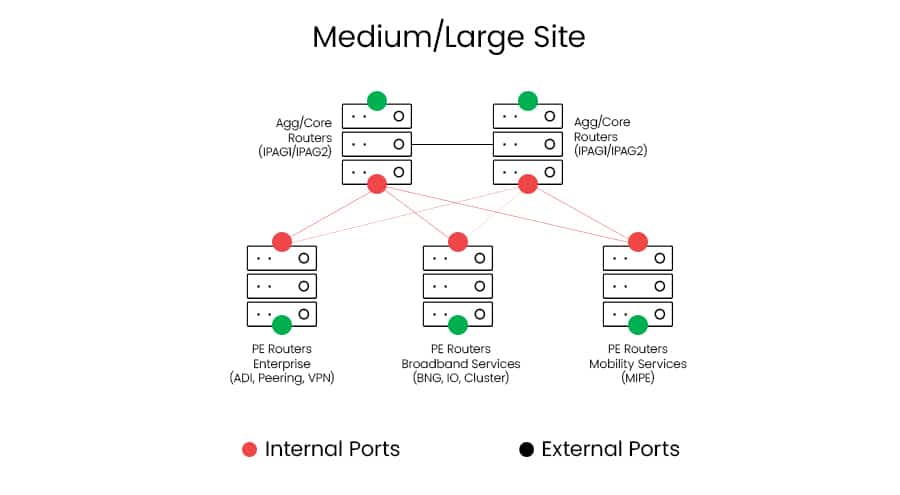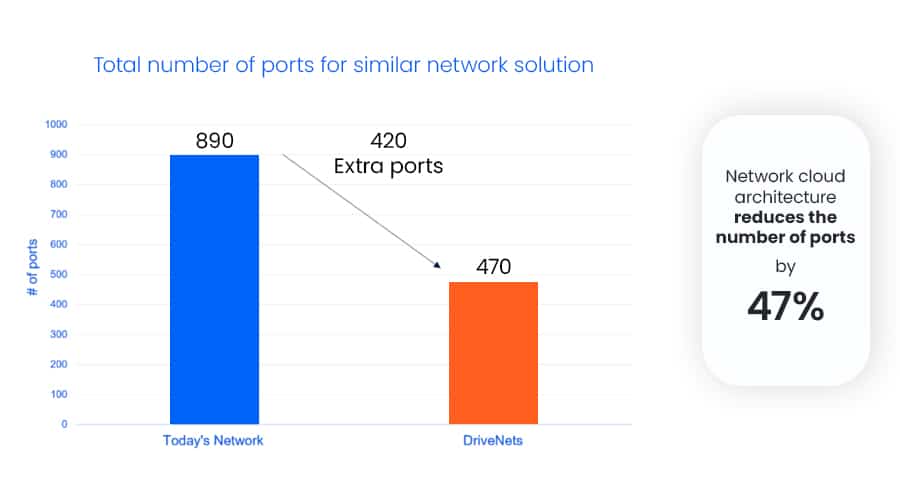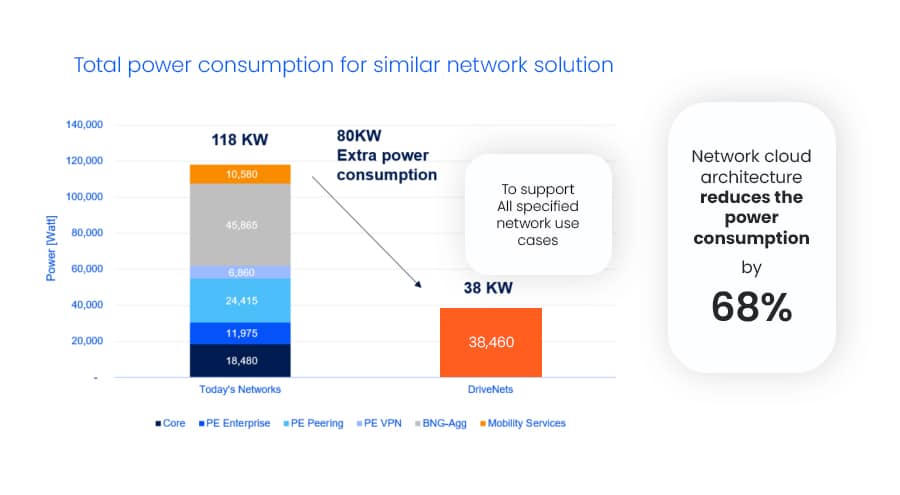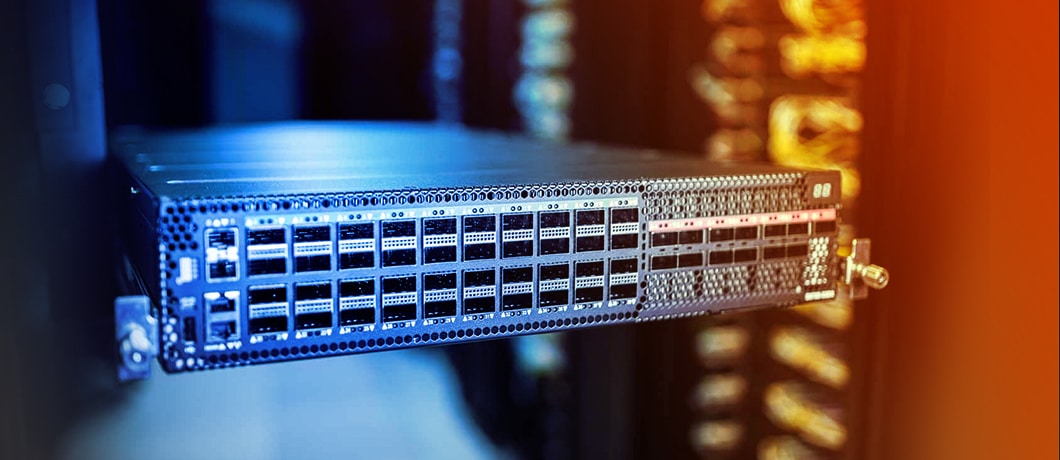The DriveNets Network Cloud solution, a distributed disaggregated network solution, applies the success hyperscalers achieved in computing infrastructure to high-scale networks. Network Cloud offers service providers (SPs) similar optimal efficiency, enabling them to streamline their most complex operations.
DriveNets recently conducted a business case study based on DriveNets Network Cloud and multiservice architecture. We found that a single multiservice aggregation site can lead to significant total cost of ownership (TCO) savings over a five-year period, and result in better operational and cost efficiency.
The business case analysis outlined the cost value of DriveNets Network Cloud vs. traditional networks. The results show that for a single multiservice aggregation site, DriveNets Network Cloud leads to $1.41M TCO savings in the first year, and a total of $3.73M for over five years.
The business case analyzed the CapEx and OpEx requirements of implementing traditional chassis-based routers (scale-up) versus a modern Network Cloud disaggregated routing architecture. We found that the multiservice architecture can reduce:
- The total number of ports by 47%
- power consumption by 68%
- RU space by 80%
Providing a unified shared network infrastructure
For this analysis, we built an aggregation site model based on real-life traffic parameters from a large Tier-1 SP’s network in a developed market.
![Better-operational-and-cost-efficiency_graph_1[23]](https://drivenets.com/wp-content/uploads/2023/04/Better-operational-and-cost-efficiency_graph_123.jpg)
To support spine-leaf (Clos) architecture, it is necessary to allocate 30-40% of port line cards for intra-site connectivity, such as intra-PoP traffic (traffic terminated in another PE within the same PoP site) and for inter-PoP traffic (traffic terminated in another PoP site). The port line cards are not available for the SP’s user connectivity since they are “sacrificed” to support the traditional PoP architecture.
With a modern, cloud-based, shared-resource methodology like DriveNets Network Cloud, service providers can optimize network resource utilization by providing a unified infrastructure that supports multiple network functions as software-based services (such as enterprise, broadband, mobile). Sharing the physical infrastructure for multiple services substantially lowers the physical footprint and number of ports, resulting in considerably lower TCO.
The business case presented in this blog post focuses only on one of the capabilities of DriveNets Network Cloud – the multiservice architecture – that addresses the inherent inefficiency of chassis-based routers. By enabling the collapse of multiple chassis routers into a single multiservice cluster, the DriveNets Network Cloud solution can dramatically reduce the total amount of hardware and software in an aggregation PoP site.
Reducing total number of ports by 47%
For the business case’s modeling assumptions, we considered multiple network use case nodes located at the same PoP site. When counting the total number of nodes and ports needed for rolling out this network topology with one of the leading vendors of traditional chassis-based routers, it was clear that there were extra hidden costs due to the extensive “internal ports” count spent on intra-site connectivity.

- Internal ports: connecting to nodes inside the central office, these ports are “wasted” on internal system connectivity rather than catering to service usage
- External ports: connecting to remote nodes and services outside the central office, these ports are for available for service providers’ actual usage
A table summarizing the total number of ports needed to support the aggregation PoP site traffic with the two types of solutions is shown in our full business case.
Network Cloud architecture was applied on the same PoP site topology, while handling the same number of external ports (i.e., 430 ports). Instead of 460 ports required in a traditional network, only 40 ports are needed for the “internal” links to interconnect the two clusters of DriveNets Network Cloud.
While the “cost per port” can be manipulated and reduced by traditional network vendors, a disaggregated Network Cloud architecture is still more cost-effective as it allows for a reduction in the total number of ports by 47%.

Reducing power consumption by 68% and rack space by 80%
When comparing the Network Cloud distributed and disaggregated router vs. a traditional chassis-based router in terms of power consumption and rack space, the value of multiservice shared network resources is even more significant.

The comparison results show that DriveNets Network cloud reduces power consumption by 68% from 118KW to 38KW. The solution collapses multiple network use cases (such as core, enterprise, peering, aggregation and so on) into a single infrastructure.
As for rack unit (RU) space, DriveNets Network Cloud reduces RU space by 80%. Assuming 42 rack units per rack, DriveNets Network Cloud uses only 2 racks versus 10 racks needed in the traditional network using chassis-based routers.
Results: disaggregated routing architecture savings
For this business case analysis, we took into consideration the following parameters:
- Cost of port: $1,700 including maintenance and support
- Cost of active optical cable (AOC): $600 per cable with two optical transceivers
- Cost of power: $0.25 per KWh
- Cost of rack unit (RU): $100 per month or $1,200 per year
As each port costs $1,700, and as a traditional network requires 420 extra ports plus 210 AOC cables, our business case shows that service providers are burdened with $840K extra CapEx spending on ports (420 ports x $1,700 + 210 cables x $600= $840K).
As the average electricity price for enterprises is $0.25/KWh, and the fact that traditional networks require 80KW of extra power, our business case shows a total of $175K extra annual OpEx spending on power consumption (8,760 hours per year x 80KW x $.25/KWh).
With regards to rack unit space, a traditional network requires 8 extra racks, each with 42 RUs, leading to $403K extra annual OpEx spending on rack unit space (8 racks x 42 RUs x $1,200/year).
Taking these issues into consideration, our business case results show that for a single multiservice aggregation site, DriveNets Network Cloud TCO leads to $1.41M savings in the first year, and a total of $3.73M for a five-year TCO calculation per site.
Benefits of building networks like cloud
Building networks like cloud delivers the agility and cost optimization of cloud to networks. The DriveNets Network Cloud solution offers optimal scale and resource utilization with shared, dynamic resource allocation and simplified physical scalability with standard white boxes. It also offers faster service innovation when rolling out software-based network services over an existing shared physical infrastructure. These advantages result in better operational and cost efficiency similar to hyperscale networks.
Download business case
Network Cloud & Multiservice Architecture




